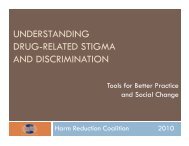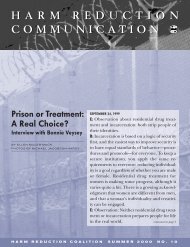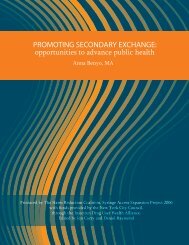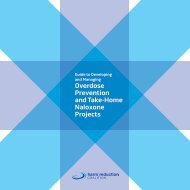9th - Harm Reduction Coalition
9th - Harm Reduction Coalition
9th - Harm Reduction Coalition
Create successful ePaper yourself
Turn your PDF publications into a flip-book with our unique Google optimized e-Paper software.
<strong>9th</strong><br />
National <strong>Harm</strong> <strong>Reduction</strong> Conference<br />
FROM PUBLIC HEALTH TO SOCIAL JUSTICE<br />
Moving from the Margins: Challenging the Isolation of <strong>Harm</strong> <strong>Reduction</strong> By The Mainstream<br />
This panel would be one I moderate and present on, which would emphasize the need for harm reduction to have greater<br />
currency among decision makers in the drugs field, and propose steps to get us there. I have some ideas for participants,<br />
and I’m sure you have also received appropriate proposals. My presentation would identify several areas where we have<br />
failed to communicate harm reduction as an approach effectively. Specifically, in both national and international arenas<br />
harm reduction is 1) mischaracterized simply as a set of interventions like needle exchange, without recognizing that the approach<br />
requires working with drug users in a way that recognizes that they are rational actors, that they have the capacity to<br />
manage risk, that they should be treated as full participants in every aspect of services involving them. As needle exchange<br />
and other health interventions targeted to drug users have moved from their grass roots origins to top-down, centralized<br />
programs by large international donors, a recognition of the philosophical orientation of harm reduction and the critical role<br />
of drug users and outreach workers cannot be taken for granted; 2) Locked out of major technical assistance streams and<br />
guidance, such as that provided by SAMSHA. By allowing practitioners of treatment orthodoxy to define what constitutes the<br />
mainstream, we have allowed the marginalization of harm reduction; and 3) Misrepresented by those who claim it is enough<br />
to call their work HIV prevention for drug users, but in reality create programs that go “behind the backs” of drug users,<br />
define “peers” in epidemiological terms but ignore drug user social networks, and focus not on drug user generated ideas<br />
of change but on “getting” clients to participate in predetermined unit of services. The presentation includes suggestions<br />
for how to move forward from the margins, in the process remaking the mainstream rather than diluting the spirit of harm<br />
reduction.<br />
Richard Elovich holds a Ph.D. in medical sociology and a Masters in Public Health. He is a specialist in public policy and program<br />
development and implementation in HIV/AIDS and substance use, with an emphasis on harm reduction and innovative and lowthreshold<br />
treatment services for at risk populations. He has over twenty years’ experience in the U.S. and internationally. In New<br />
York, he was Director of HIV Prevention programs for GMHC, the oldest and largest non-governmental AIDS organization in the<br />
U.S. He is an experienced advocate, having been appointed to the Mayor’s HIV Planning Council of New York City, and chairing its<br />
substance abuse services work group from 1991-1996. Elovich was an organizer of underground needle exchange programs in<br />
New York City and San Juan, Puerto Rico. He has been a full-time instructor in the Urban Public Health program at Hunter College’s<br />
School of Health Sciences, City University of New York and a guest lecturer at numerous universities and colleges. Since<br />
2003, Elovich has worked as a consultant on HIV/AIDS and drug use issues throughout the former Soviet Union, including Central<br />
Asia, Nepal, Thailand, Indonesia and Mexico.<br />
Ervin, Sonja, Central City Concern, Portland, OR<br />
sonja.ervin@ccconcern.org<br />
<strong>Harm</strong> <strong>Reduction</strong> & Integrated Care Environments; Challenging Staff’s Bias to Focus on Outcomes<br />
The experience and expertise of the Community Engagement Program (CEP), a program that has utilized a harm reduction<br />
approach for the past 9 years. CEP has been nationally recognized for its services which include a community outreach approach<br />
to the most vulnerable individuals who are experiencing chronic homelessness and significant disabilities. Pulling<br />
from the experiences of staff who come from varying backgrounds including their own addictions, mental health concerns<br />
and homelessness, we will provide an interactive discussion to address struggles faced by individual staff, programs and<br />
agencies to define harm reduction and develop reportable outcomes for a model that demonstrates success individually.<br />
Design and Outcomes of an Integrated <strong>Harm</strong> <strong>Reduction</strong> Approach<br />
Poster presentations will provide an overview of the Community Engagement Program including the Mission statement<br />
developed by the program staff, outline of the integrated services provided in the program, staffing –types and levels, case<br />
studies of program participants benefiting from a harm reduction approach and presentation of a cost avoidance study conducted<br />
with program participants as well as other data that demonstrates long-term stability for individuals in the program.<br />
Sonja Ervin is the former Program Manager for the Community Engagement Program (CEP) and Housing Rapid Response (HRR),<br />
38











